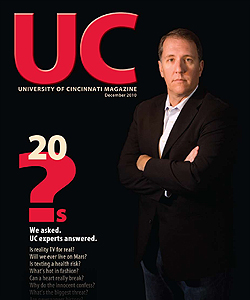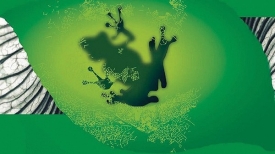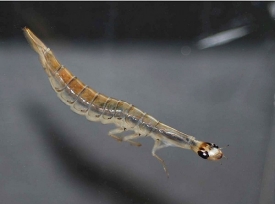Medical Breakthroughs
Firefighters' cardiac risks
Firefighters are exposed to dangerous levels of ultra-fine particulates at a time they are least likely to wear protective breathing equipment — when decreased smoke has caused them to remove protective facemasks while trying to keep debris from re-igniting, UC environmental-health researchers say. Firefighters may be facing an increased risk for heart disease because of exposure to particles invisible to the naked eye but inhaled into the deepest pockets of the lungs. Researchers also note that much of this exposure could be avoided through equipment improvements and protocols such as rotating firefighters more frequently.
Reducing asthma in schools
To study environmental links to asthma, which affects up to 24 percent of Cincinnati's school children, UC environmental-health researchers are partnering with Cincinnati Public Schools and the Cincinnati Health Department to examine how idling buses and traffic near schools impact children's health. After comparing indoor and outdoor air samples from both schools and adjacent communities, researchers expect to develop an anti-idling campaign to reduce diesel exhaust from buses, then measure the impact afterward.
Earlier onset of puberty
Girls now experience the onset of puberty at younger ages, according to UC College of Medicine and Cincinnati Children's Hospital Medical Center researchers. Their study showed that breast development occurred in more 7- and 8-year-old girls, especially white girls, than indicated in studies conducted 10 to 30 years earlier. Previous studies also linked an increased risk of breast cancer to an earlier age of the first menstrual period.
Frog foam inspires biofuel
UC researchers earned the 2010 Earth Award for an artificial photosynthetic foam that converts solar energy to sugars, which then can be converted to biofuels like ethanol. Inspired by foam nests that certain semi-tropical frogs make, the artificial foam removes carbon dioxide from the air. If used in carbon-dioxide-rich environments, like coal-burning power plants, the foam could capture carbon dioxide from the exhaust before it was released to the atmosphere. The Earth Awards, a global innovation contest, links viable green ideas to investors.
Parkinson's model tested
UC Neuroscience Institute researchers are in the final step of testing a new drug-delivery model for Parkinson's disease — a degenerative neurological disorder that causes certain dopamine-producing brain cells to die. In these clinical trials, a physician inserts a small tube into the body to feed levodopa (the precursor of dopamine) into the upper intestine. The medication is supplied in a gel form from a cassette worn outside the body with a programmable pump allowing the patient or physician to adjust the medication.
Researchers say this continually "bathes" the patient in dopamine. In general practice, oral medication is taken at certain times of the day, stimulating the brain at artificial intervals. Abbott's levodopa-carbidopa intestinal-gel treatment is currently being tested for safety and effectiveness in Phase III clinical trials, the final step before study results are submitted to the Food and Drug Administration to obtain a New Drug Application.

 Issue Archive
Issue Archive




